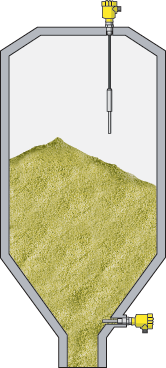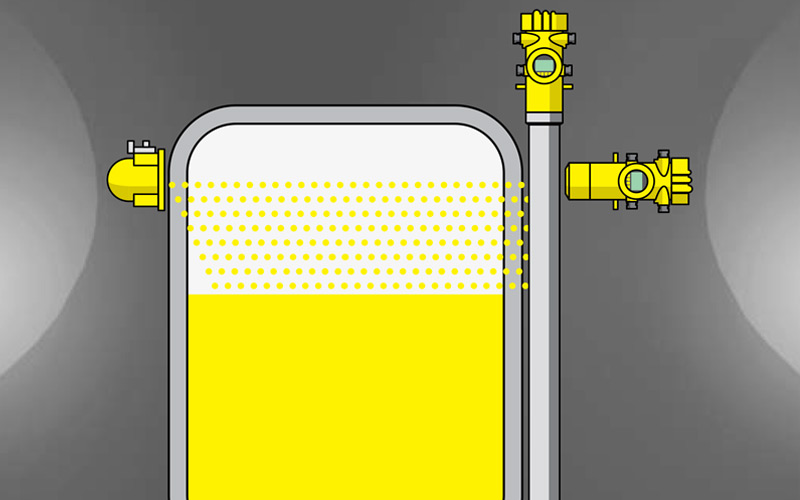Level Measurement 101: Point Level Switches – A Simple On and Off
Point level measurement is just what it sounds like: measuring liquids or bulk solids in a vessel up to or down to a certain point. Process engineers may not always need to know exactly how much material they have in a vessel at any given time, but they do need to know if a vessel is about to overflow or run out completely. That’s where point level devices come in.
Point level switches are typically placed near the top of the vessel, where operators would like a “full” line to be, and conversely, they can be placed near the bottom, where operators would like an “empty” line to be. Once the switch is activated, it can initiate an alarm (light or horn), send a signal to start or stop the process, or initiate an action. There are a number of ways to accomplish this task with varying price points. These range from the more simple mechanical and magnetic switches to more advanced switches using vibration and capacitance. For the purpose of brevity, this paper will focus on some of the more advanced technology used with switching, namely vibration, capacitance, microwave, and radiometric.
Good Vibrations
Vibration switches are contact instruments that monitor frequency or amplitude to determine when a liquid or a bulk solid has reached the switch point. These switches constantly vibrate at a specific frequency or amplitude. The frequency is the time between the start of one wave and the start of the next. The amplitude is the height of those waves or pulses. Once the medium comes into contact with the probe, it causes the frequency or the amplitude to change, and this change activates the output.
Installation is nearly just as simple since these are “plug and play” devices, meaning they’re ready to go as soon as they’re mounted and connected. There is no need for an additional setup or calibration. These types of switches work in a variety of environments, including pressurized and unpressurized vessels, while providing reliable measurements with little to no maintenance costs. In most cases, these switches can be installed without a process shutdown, making them an ideal option for any process where all that’s needed is a simple “full” measurement. A low level measurement may require additional steps, but that’s only because the vessel would need to be emptied to the point of where the desired level will be taken.
Capacitance and Point Level Measurements
Capacitance switches are also contact instruments, but they measure the capacitance, or the medium’s ability to hold an electrical charge. These types of switches can be used with both conductive or non-conductive liquids and solids and are looking for step changes in standing capacitance, measured in picofarads.
To create a capacitor, two plates are needed. The capacitance changes when the distance between those two plates changes, the size of the plates changes, or the product’s dielectric changes. Once the liquid or bulk solid being measured reaches the area between the two plates, the capacitance changes, and the switch output changes state.
These types of switches require more of a set-up than their vibrating counterparts. These instruments must be installed and set up in process to see the different states expected for changes. These switches need to know the different capacitance values for a vessel that’s full and a vessel that’s empty.
Point level detection without a probe
The two technologies discussed so far both involve a probe touching the material being measured. That’s not the case for microwave barrier and radiometric switches. Both of these technologies use a beam of sorts, and once that beam is broken or interrupted, the switch is activated. This also means both of these technologies use two different parts – a transmitter or source from where the beam originates and a receiver. Both technologies can be used for liquids and solids, and each are non-contact.
Versatility of Microwave Barriers
The microwave barrier can be used in more creative ways than the two switching technologies previously discussed. For example, VEGA offers a microwave barrier switch, the VEGAMIP, which has a sensitivity adjustment, time delay for falling product, high temperature options, and abrasion adapters. Microwave barrier switches can provide “full” or “empty” options, similar to vibration and capacitance switches, but they can also be used to determine when product is falling into a vessel or onto a conveyor belt as well as for positioning information.
Determining whether or not product is falling is more common with bulk solids. For example, a coal power plant was having issues with the mechanical switches in their coal feeders. These feeders moved coal from the pile to the conveyor belt, but the mechanical switches, which needed contact with the coal to work, kept getting stuck, preventing operators from knowing when a chute was plugged. This slowed down efficiency.
New microwave barrier switches at the coal power plant had no contact with the material falling onto the conveyor, and therefore, operators knew as soon as a chute was clogged. Utilizing the time delay feature of the VEGAMIP, the falling product was ignored until it was “solid” between the transmitter and receiver indicating a plugged chute.
Radiometric for the Toughest Applications
Radiometric switches work similarly in principle to microwave barrier switches, but instead of using microwaves as a barrier to be broken, these instruments use gamma radiation emitted from a source holder while a detector measures the amount of radiation reaching it. And unlike microwave barrier switches, radiometric switches can be installed completely externally, which is why they’re typically used to measure harsh or volatile processes like those seen in oil refining, the chemical industry, and mining.
These switches can serve a number of purposes, including the simple “full” and “empty” indications. Since radiometric switches measure the amount of gamma radiation emitted from the source holder, this reading will decrease once the material being measured attenuates the field between the source and the sensor. This informs operators the vessel has reached the full point. The reverse is true for switches measuring the empty point.
Because of how they work, radiometric switches can be used for vapor detection, and auto-zeroing in complex processes using multigauge systems. Again, they’re measuring the amount of radiation emitted from the source, so if vapor builds, preceding a rising medium, the reading on the sensor will begin to drop ahead of the actual full switch point. For example, in coke drums used in the refining industry, these switches are used near the top of the coke drum to give operators an early notification of their boiling hot, bubbling heavy crude. These same type of switches are used at the bottom of the coke drum because they can provide an “empty point” and use that data to auto-zero a continuous level gauge on the side of the vessel.
Conclusion
Switches are excellent at determining point level. After all, that’s their sole purpose. The medium is either touching the switch or it’s not, signaling a point level for the material being measured. Microwave barrier switches and radiometric switches use an “invisible” barrier to accomplish the same task. The information provided by these switches allows operators or a system to function without overfilling or running empty. Preventing either of these from happening is just another layer of safety point level switches provide. For the right application, switches are an economic, low-maintenance, and easy-to-use option.
*Article last updated March 2023
Related products
Export this article
Download as PDFShare this article
Comments ({{comments.length}})
{{getCommentAuthor(comment, "Anonymous")}} {{comment.timestamp | date : "dd.MM.yyyy HH:mm" }}
{{comment.comment}}







